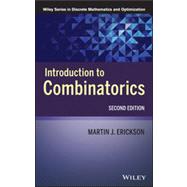
Note: Supplemental materials are not guaranteed with Rental or Used book purchases.
Purchase Benefits
What is included with this book?
MARTIN J. ERICKSON, PhD, is Professor in the Department of Mathematics at Truman State University. The author of numerous books, including Mathematics for the Liberal Arts (Wiley), he is a member of the American Mathematical Society, Mathematical Association of America, and American Association of University Professors.
Preface xi
1 Basic Counting Methods 1
1.1 The multiplication principle 1
1.2 Permutations 4
1.3 Combinations 6
1.4 Binomial coefficient identities 10
1.5 Distributions 19
1.6 The principle of inclusion and exclusion 23
1.7 Fibonacci numbers 31
1.8 Linear recurrence relations 33
1.9 Special recurrence relations 41
1.10 Counting and number theory 45
Notes 50
2 Generating Functions 53
2.1 Rational generating functions 53
2.2 Special generating functions 63
2.3 Partition numbers 76
2.4 Labeled and unlabeled sets 80
2.5 Counting with symmetry 86
2.6 Cycle indexes 93
2.7 Pólya’s theorem 96
2.8 The number of graphs 98
2.9 Symmetries in domain and range 102
2.10 Asymmetric graphs 103
Notes 105
3 The Pigeonhole Principle 107
3.1 Simple examples 107
3.2 Lattice points, the Gitterpunktproblem, and SET® 110
3.3 Graphs 115
3.4 Colorings of the plane 118
3.5 Sequences and partial orders 119
3.6 Subsets 124
Notes 126
4 Ramsey Theory 131
4.1 Ramsey’s theorem 131
4.2 Generalizations of Ramsey’s theorem 135
4.3 Ramsey numbers, bounds, and asymptotics 139
4.4 The probabilistic method 143
4.5 Sums 145
4.6 Van der Waerden’s theorem 146
Notes 150
5 Codes 153
5.1 Binary codes 153
5.2 Perfect codes 156
5.3 Hamming codes 158
5.4 The Fano Configuration 162
Notes 168
6 Designs 171
6.1 t-designs 171
CONTENTS ix
6.2 Block designs 175
6.3 Projective planes 180
6.4 Latin squares 182
6.5 MOLS and OODs 185
6.6 Hadamard matrices 188
6.7 The Golay code and S(5, 8, 24) 194
6.8 Lattices and sphere packings 197
6.9 Leech’s lattice 199
Notes 201
A Web Resources 205
B Notation 207
Exercise Solutions 211
References 225
Index 227
The New copy of this book will include any supplemental materials advertised. Please check the title of the book to determine if it should include any access cards, study guides, lab manuals, CDs, etc.
The Used, Rental and eBook copies of this book are not guaranteed to include any supplemental materials. Typically, only the book itself is included. This is true even if the title states it includes any access cards, study guides, lab manuals, CDs, etc.